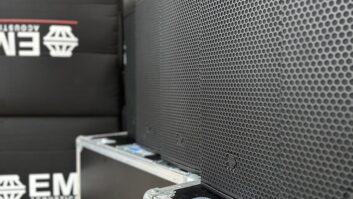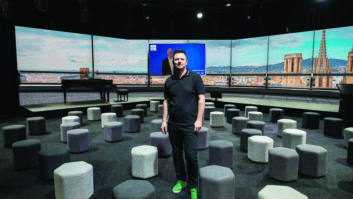Professional audio and public address (PA) were once rigidly defined areas of sound installation. Today, because of the need for higher sound levels and better quality, equipment more associated with concerts and touring is being installed in stadiums, arenas and other venues. This makes sense because sports clubs and shopping centres increasingly want to provide more entertainment, but the complication is that PA is usually paired with voice alarm (VA) in case of an emergency.
Despite that, over the past nearly 30 years, more sport venues have installed sound systems that cater for both announcements and entertainment, as Ian Bridgewater, director and technical sales manager at TOA UK, explains: “Visitor expectations, multi-functionality and the need to be flexible to create the greatest revenue has prompted organisations to look at the design of multi-use systems to ensure they are maximising their income potential.”
 Chris Barrow, product manager for loudspeaker products at Biamp, which includes Community, observes that over the last 20 years in particular there has been a “long progression” from voice-only operations in public and sports entertainment spaces. “Certainly in the US it’s fairly rare to have a voice-only system installed, unless it is just an absolute budget installation,” he says. “Everybody incorporates some amount of music because they want entertainment to keep people seated and engaged in whatever’s going on.”
Chris Barrow, product manager for loudspeaker products at Biamp, which includes Community, observes that over the last 20 years in particular there has been a “long progression” from voice-only operations in public and sports entertainment spaces. “Certainly in the US it’s fairly rare to have a voice-only system installed, unless it is just an absolute budget installation,” he says. “Everybody incorporates some amount of music because they want entertainment to keep people seated and engaged in whatever’s going on.”
Higher SPLs and greater speech intelligibility have been key technical reasons for installing pro audio systems but better overall sound is also a priority. “As the quality of audio continues to improve at both musical and non-musical events, the public’s expectation and appreciation of quality audio also increases,” says Scott Wakelin, business development manager for sports facilities and cruise ships at L-Acoustics. “In shopping centres there is a simultaneous need for calming background music, which creates a pleasant ambience and extends the amount of time shoppers spend in the venue, as well as for announcements and messaging, which should be warm and welcoming. Definitely not the throaty horn sound of old school PA.”
RCF also reports an increased demand for improved audio in “several applications”, although that varies from country to country. “Investing to offer intelligible announcements and performance entertainment seems more assimilated,” says Antonio Ferrari, director of the RCF engineering support group. “We also have to thank associations, like FIFA and UEFA, and security standards that contribute to set high intelligibility and SPLs, mainly in crowded environments.”
Robin Dibble, product support engineer at Martin Audio, agrees that stadium sound has improved over the years, particularly as decent production values are now a major part of live sport. “High quality audio is an integral part of the fully produced content on offer, including music, pitch-side interviews and advertising,” he says. “And it is way beyond the statutory requirements for speech intelligibility and SPL for evacuation purposes.”
The new stadiums and arenas that have been built over the last 30 years are bigger in size and capacity than those that went before. This, as Saben Shawhan, director of audio application support and partner business development at Harman, points out, has put greater pressure on old style PA equipment. “A large footprint or high background noise or reverberation time [means] the traditional speaker fire alarm, announcer boxes don’t have the ability to project on top of a crowd or carry a room of that size, especially when it comes to speech and speech intelligibility,” he says. “You have to start looking at products and system designs that can deliver high intelligibility into the audience that may also include much greater SPLs.”
 Because of the crucial VA aspect of PA, national, regional and international standards have appeared to ensure minimum parameters for performance and quality. EN 54 is the European standard for fire detection and fire alarm systems and includes two audio sections: EN 54 Part 16, VA control and indicating equipment; and Part 24, the loudspeaker component of VA systems. All PA/VA manufacturers work to these but there is concern that not all pro audio equipment is similarly certified. “Sporting venues and stadiums now have more of a bias [towards] the pro side,” comments Peter Alberry-King, general manager (technical) at PA/VA specialist Penton UK. “The motive for that is to have a system for geeing up the crowd but there is also a requirement for it to be a life safety system, which has to be certified to EN 54-24.”
Because of the crucial VA aspect of PA, national, regional and international standards have appeared to ensure minimum parameters for performance and quality. EN 54 is the European standard for fire detection and fire alarm systems and includes two audio sections: EN 54 Part 16, VA control and indicating equipment; and Part 24, the loudspeaker component of VA systems. All PA/VA manufacturers work to these but there is concern that not all pro audio equipment is similarly certified. “Sporting venues and stadiums now have more of a bias [towards] the pro side,” comments Peter Alberry-King, general manager (technical) at PA/VA specialist Penton UK. “The motive for that is to have a system for geeing up the crowd but there is also a requirement for it to be a life safety system, which has to be certified to EN 54-24.”
Pro sound companies have looked into this certification, but not all pro loudspeakers are fully EN 54 compliant. “For loudspeakers, certification to standards can take a different approach,” says Martin Audio’s Robin Dibble. “In some cases EN 54 certification is a necessity, in others, as long as the spirit of the relevant standards is adhered to and all necessary steps have been taken to ensure safety and risk management is present, non-EN 54 rated loudspeakers can be used. It must also be proved that they are necessary to attain the required performance and meet venue specifications where no EN 54 devices can.”
CLEAR CUT
Ian Bridgewater at TOA views the situation in more clear-cut terms: “If it is pure PA and not being used for VA, then the components do not need to be EN 54 certified. However, any system or part of a system, such as loudspeakers, which is being used for life safety evacuation must be EN 54 certified.” Antonio Ferrari of RCF takes a broader view, saying the intelligibility and overall audio performance of pro audio systems are “far above” the requirements of VA system standards: “The main constraint to get a pro audio EN 54 certified system in a large public place or stadium suitable for both entertainment and evacuation is the standby power supply that, due to the high power required/absorption cannot be run by EN 54 Part 4 48VDC power supply equipment.”
Community has, comments Chris Barrow, been producing EN 54-24 products for nearly ten years, the most recent of which is the LVH-900 beam-forming venue horn. “We’re focusing most of our efforts, at least in EN 54, on the stadium, the stadium concourse and ancillary area markets,” he says. “We want to make sure we have EN 54 product that can go in and around these higher SPL, high intelligibility spaces. Even if we don’t get certification for a product, I’d like to make sure our spec sheets have the information presented as if it was an EN 54-24 loudspeaker.”

As Barrow adds, no venue operator likes the idea of installing one system for music and one
for speech/voice. “We want to give them an option to install one system that does both jobs,” he says. “[But] one of the things we fight with in pro audio is the EN 54 specification is not written in a way that pairs up with pro audio very well, there’s a lot of grey areas and designs that aren’t mentioned in EN 54, which wasn’t designed with large loudspeakers that require thousands of Watts to run in mind.”
Saben Shawhan at Harman, which also produces EN 54 compliant products, comments that a major problem is often arena and stadium sound systems do not meet full life safety certification because each individual component cannot meet that requirement. “So it’s treated as a secondary source of broadcast,” he explains. “In an emergency the system would mute its normal operations and rebroadcast the same message that’s going across the fire alarm. That covers you from the intelligibility and SPL standpoints to get over all the audience but the system in its entirety is not truly certified as a standalone life safety system.”
It is obvious that VA should not have any grey areas and where there are, the kit should be able to perform the job, regardless of certification. General PA has become more flexible and where good quality sound and clarity is concerned, pro audio has certainly staked its claim in this parallel market.







